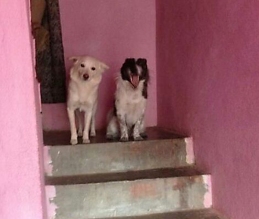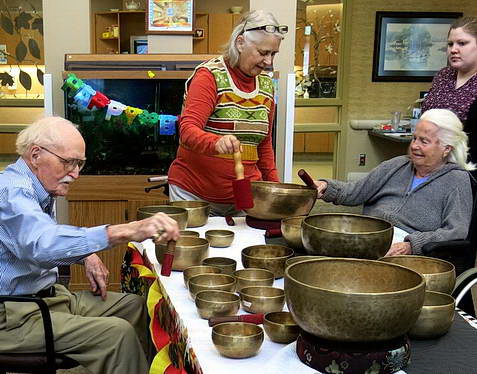
Our guest-blogger Frank Perry is a recording artist, composer, astrologer, mystic, Singing Bowl expert since the early 70’s and author of the compendium “Himalayan Sound Revelations”. Now in its second printing of the second edition, his book is undoubtedly the most comprehensive book on Singing Bowls ever written. However, one subject I’d wished it had covered more was his take on bowls and the Chakras, which is a question I am asked almost every day. We’d been having a lively exchange on this subject for the past couple of years, so I asked him to give us his insights…
 Many persons involved with singing bowls consider them to be musical instruments – such as would be used to apply the 7 notes of our musical scale to the chakras. A few others and I do not subscribe to this belief and practice. If it works for you, then fine. If it doesn’t ‘rings true’ then please read on.
Many persons involved with singing bowls consider them to be musical instruments – such as would be used to apply the 7 notes of our musical scale to the chakras. A few others and I do not subscribe to this belief and practice. If it works for you, then fine. If it doesn’t ‘rings true’ then please read on.
I have no desire to destroy the work of anybody in this field. Recent research challenges what had previously appeared to be a rock-solid system of the chakras. But I feel it is important to not shy away from truth. It is simply necessary to reconsider our position.
Outlined here are some issues I have regarding the current way of attributing the 7 white piano keys to the chakras and then to singing bowls:
- There is one chakra system
- The 7 white notes of our piano are those for the chakras
- Himalayan singing bowls are made for working this way on chakras.
100 years ago, Arthur Avalon writing about the chakras published “The Serpent Power”. For a very long time this was established as being the only system of the ancient Tantrik chakra systems referred to. If the chakras were ever mentioned this system would come to mind. An entire industry of writers, yoga teachers, workshop leaders, yogis, sound healers and singing bowl suppliers is now firmly established around this one single system with many Western practices superimposed upon it for which nobody is to blame, and (in its original form one of the many genuine systems) all are certainly free to continue adhering to.
According to Christopher Tompkins (Sanskrit scholar and yogi – http://shaivayoga.com/Home.html), our current chakra system stems from Purnananda Swami who wrote about this one system (‘system of six chakras’) 500 years after the original source, the Kubjika Tantra, (itself one of nine Tantrik lineages) in 1577 CE. However, it now transpires there are many such systems (Tantras) with some being based on 5 chakras, or 6, 7, 9, 10, 15, 21, 28, etc – according to which Tantrik text you are looking at. Some of these chakras are in regions totally unfamiliar e.g. the palette. Then in 1918 Sir John Woodroffe (under his pen name Arthur Avalon) published his English translation of Purnananda’s book (‘The Serpent Fire’). Purnanada’s book had no information regarding what to do with that system.
Regarding the seven notes for the chakras, we should also bear in mind that the Sanskrit alphabet has 50 letters (the ‘Garland of Letters’) and in our familiar system the first six chakras have a total of fifty petals. Therefore, taking the Root chakra as our example, there are four petals each with its own sound. Then there is a Bija mantra linked to each chakra. So, in this Root chakra there are five sounds and not one, and with the Heart chakra 13 sounds, etc. Then a further complication arises with each Bija mantra, as these are those for the five elements. These can be placed in any chakra – only adhering to the same ascending sequence. For example, the Earth element could be placed in the Solar Plexus chakra and followed on with the Water element placed in the Heart chakra, and then Fire situated at the Throat, etc. This would result in the sounds of the Bija mantras being in different chakras to that of the current system. In addition to this, it further transpires that there is a translation error regarding the sound (spelling) of these Bija mantras. However, Woodroffe was a Sanskritist, and in Purnanada’s book the actual Bija mantras are missing their vowels. It was common parlance to assume the short ‘a’ in such instances. And so, we have inherited the sequence Lam, Vam, Ram, Ham, Om. But actually: – LAM, VIM, RUM, YAIM, HAUM, OM.
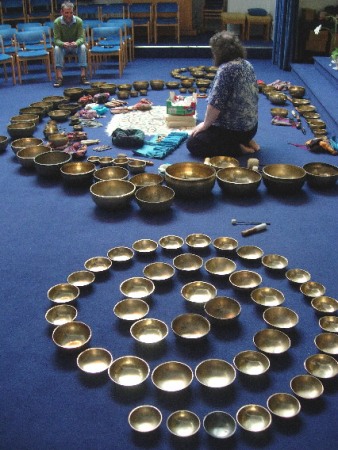
Working with music since 1964 and with singing bowls since 1971, I’ve yet to discover any ancient texts that put a musical note to the sounds for the chakras. Even were these ancient people to have done so, it is highly unlikely for this to be the seven notes of our C Major scale! – let alone in the pitch standard of today and in Equal Tempered tuning (which we only adopted in the 20th century) when one such unpublished system of five chakras (from the heart chakra upwards – no lower three chakras) comes from 500 – 700 CE. I contest that at such an early date any kind of familiarity with Western music (as it was then!) is most improbable. It is undeniable that correspondences could have been found within the musical scales of India but I’m not yet aware of any tradition (ancient or modern) regarding this.
Tibetologist Dr. Alain Presencer (1981 LP ‘The Singing Bowls of Tibet’) and I believe singing bowls are not, and were never intended to be, musical instruments. The nature of the sound of singing bowls is such that several sounds are heard together when struck. This is not the case with musical instruments that produce a distinct musical note when struck (or blown or bowed or sung [apart from overtone singing]). In this regard, it matters little whether we refer to a system of 5, 6, 7, 10, 28 chakras, whatever, it will remain very demanding to fit any one singing bowl to one single exact frequency.
Even if we’re not concerned with ancient systems but are happy to link seven chakras to seven musical notes, singing bowls are a poor choice for applying this system. In my experience, apart from sounding several frequencies (more akin to a musical ‘chord’), hand-hammered singing bowls will often produce slight variations in their sound when struck at different points around the rim. When I first find a bowl, I will experiment to find that strike point which seems to produce the optimum sound from the bowl. However, I also have a problem with these seven notes spanning one octave out of seven. This seems a narrow span of tones for seven chakras that refer to the spiritual evolution of our consciousness unfolded through initiatory experience. Fabian Maman uses seven notes in his model of sound healing although these follow a cycle of Fifths and so cover more than one octave: F, C, G, D, A, E, B (F2 to B5. 1997). Then, James D’Angelo, another musician in the field, favours a pentatonic scale also beginning on F: F, G, A, C, D, F, G. This extends just beyond the octave (applied to seven chakras).
The system of chakras is part of our ‘nature’. An additional problem lies in our modern music (based, as it is, upon the ‘Fixed Pitch’ piano) being out-of-tune with the ‘nature’ of sound (harmonics or the overtone series). In the time of Pythagoras, the notes of our diatonic scale derived from the ratios found in the overtone series. E.g. 9/8, 5/4, 6/5, etc. This is called ‘Pure Tuning’. When a guitar string is plucked it is possible to hear the various overtones sounding harmoniously together. Furthermore, it is then possible to isolate one of these overtones through gently placing a finger upon the point of one of these ratios e.g. two thirds of the length of the string. When we then press the string down from this position upon a certain fret to hear this harmonic (pitch) it would not be quite the same sound frequency. This is because our current ‘Equal Tempered’ tuning system has derived the several notes of the scale from an algorithm. However, there have always been problems with tuning this scale stemming from trying to resolve the ‘Pythagorean Comma’. (Please see diagram/table below – courtesy of Wikipedia). This is not the case with other musical scales in the world that derive from different geometric progressions. It must also be said that bells and singing bowls don’t obey the same law that governs musical instruments. Each bowl has its own unique set of overtones.
This chakra system of our subtle body is just that – SUBTLE! As humanity moves from the fifth post-Atlantean root race towards the sixth, so we move from intellect to intuition. Accordingly, perhaps it is better to work intuitively with the bowls rather than applying an intellectual rationale or mechanistic paradigm.
So. If we drop this current system of finding a bowl close to a musical note, which is then said to be that for a certain chakra, how do we proceed?
We may feel the area of a chakra being affected directly by a certain singing bowl – a physical sensation or resonance within that chakra. Or we may listen to see if we can hear in the sound of a bowl something of the qualities or virtues of an individual chakra. The Heart chakra is concerned with love. Can we sense that the sound of a bowl helps us to feel in-tune with this loving quality? Does it enhance our love for our fellow beings (compassion), or does it awaken a spiritual aspiration towards divine love? Does it speak of a child-like simplicity or does the sound carry more of a reassuring, comforting, gentle, and safe quality to help us open our heart when it is closed due to past hurt? Does it centre our focus upon the Heart chakra stirring the seed-atom of that sacred centre? Does it inspire courage to deal with trials of life e.g. threatening illnesses such as Cancer? Does the sound echo the conscious awareness of living within a great ocean of love?
I’ve found bowls for twelve chakras (within the body) and 5 of these I only discovered existed some years after I had analysed the bowls. With my first singing bowls in 1971 there was no link between bowls and chakras or anything else. There were simply bowls for sale. You liked one or you didn’t. In the early 80s I found a few ancient bowls affected certain of my chakras and shared such insights in my workshops which certain merchants attended and then turned into selling points. When in the business of looking for bowls, I ignore any claims and simply find what any bowl does for me. Notices in shops stating the bowls are traditionally used for mediation and healing I pay no attention to. I’ve even been in a shop that advertised Healing Bowls. Full of lovely, old antiques with a good sound, but none I could use in my sound healing.
Maybe simply find a bowl (or however many) that you love. If it takes you on a journey into the mysteries of sacred sound, then enjoy that grace. If it relaxes you, or quietens your worldly mind, or reacts with any chakra of yours, or turns you inwards to your real Self, then you can go forward grounded in your own experience. You will be guided into how you may work with them. This is the Way of the Bowls.
Sound is related to the Throat chakra the name of which translates as ‘Pure’. To clearly experience the effect of a bowl one needs to have achieved a degree of purity to obtain a clear and true reflection.
These two diagrams (courtesy of Wikipedia) show how the natural Overtone series (Harmonics) differs in pitch to that of our musical scale as performed upon any Western musical instrument. Diagram #1 shows how different the pitch is between any one harmonic (aka. overtone) and the note in our musical scale (Up or Down – ‘Sharp’ or ‘Flat’ in musical terms).

Diagram #2 shows the Variance in frequencies in (musical) cents between the Harmonics (1 – 31) of say, a string on the cello, and its musical Note (with + above the Note and – Below it).
| Harmonic | 12TET Interval | Note | Variance cents | ||||
| 1 | 2 | 4 | 8 | 16 | prime (octave) | C | 0 |
| 17 | minor second | C♯, D♭ | +5 | ||||
| 9 | 18 | major second | D | +4 | |||
| 19 | minor third | D♯, E♭ | −2 | ||||
| 5 | 10 | 20 | major third | E | −14 | ||
| 21 | fourth | F | −29 | ||||
| 11 | 22 | tritone | F♯, G♭ | −49 | |||
| 23 | +28 | ||||||
| 3 | 6 | 12 | 24 | fifth | G | +2 | |
| 25 | minor sixth | G♯, A♭ | −27 | ||||
| 13 | 26 | +41 | |||||
| 27 | major sixth | A | +6 | ||||
| 7 | 14 | 28 | minor seventh | A♯, B♭ | −31 | ||
| 29 | +30 | ||||||
| 15 | 30 | major seventh | B | −12 | |||
| 31 | +45 | ||||||
Copyright Frank Perry 13th October 2018

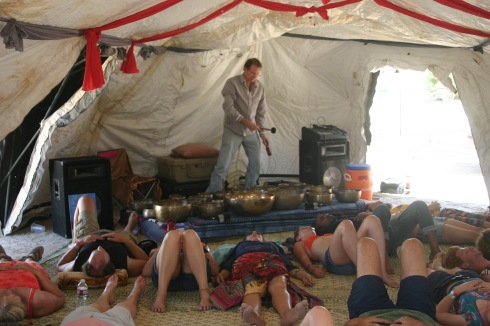

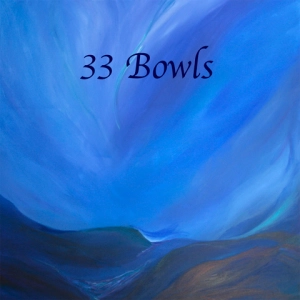
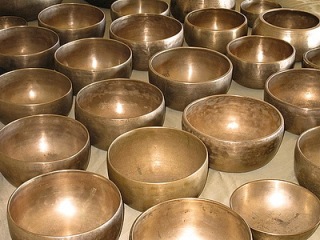
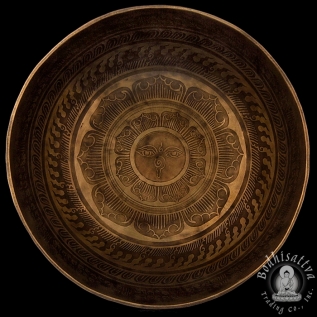
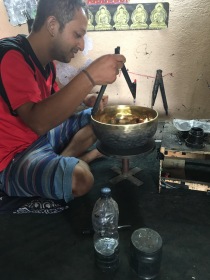
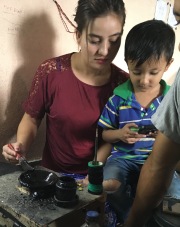 Having no formal training, Suraj became interested in art around the age of 14. His father passed away when he was 3, so he was raised in part by his grandfather, a Newari craftsman. So at an early age, Suraj was exposed to his grandfather’s work designing cast singing bowls and metal mala beads. Neha started producing art in 2012, and developed her natural talent for the work. Sujyan, while not taking pictures on the family smart phone, also practices the craft.
Having no formal training, Suraj became interested in art around the age of 14. His father passed away when he was 3, so he was raised in part by his grandfather, a Newari craftsman. So at an early age, Suraj was exposed to his grandfather’s work designing cast singing bowls and metal mala beads. Neha started producing art in 2012, and developed her natural talent for the work. Sujyan, while not taking pictures on the family smart phone, also practices the craft.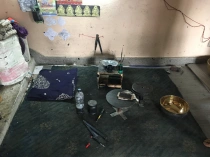
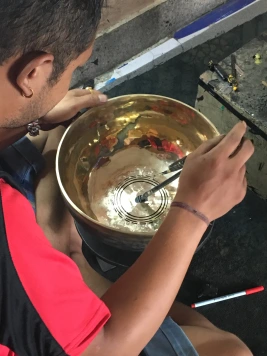
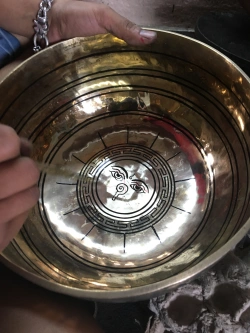 In this bowl’s case, Suraj has chosen the central image to be the Buddha’s Eyes, also known as the Wisdom Eyes. This iconic Nepali image depicts the Buddha’s eyes and Third Eye, as well as a stylized nose that is the same shape as the Nepali numeral one. This symbol signifies the unity of all existing phenomena. The image reminds us that the Buddha is always watching us and our actions. The image is pervasive in Nepal, from tourist products and car decals to the steeples of Buddhist Stupas. At this point, Suraj removes the tape, and paints the rest of the work on the bowl in freehand. To create the central image, Suraj first sketches the eyes, nose and third eye with a red pen, then expertly fills it in with his brush. The inner 6 concentric circles of the basin pattern become a Yantra pattern, a mystical, geometric diagram from the ancient Tantric tradition said to be energized by the deity.
In this bowl’s case, Suraj has chosen the central image to be the Buddha’s Eyes, also known as the Wisdom Eyes. This iconic Nepali image depicts the Buddha’s eyes and Third Eye, as well as a stylized nose that is the same shape as the Nepali numeral one. This symbol signifies the unity of all existing phenomena. The image reminds us that the Buddha is always watching us and our actions. The image is pervasive in Nepal, from tourist products and car decals to the steeples of Buddhist Stupas. At this point, Suraj removes the tape, and paints the rest of the work on the bowl in freehand. To create the central image, Suraj first sketches the eyes, nose and third eye with a red pen, then expertly fills it in with his brush. The inner 6 concentric circles of the basin pattern become a Yantra pattern, a mystical, geometric diagram from the ancient Tantric tradition said to be energized by the deity.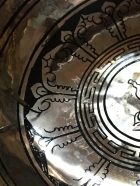 Returning to his original red reference lines, Suraj fills in perfectly straight connecting lines of the mandala image, visually measuring the distance between them with precision. These spokes will become flower petal shapes that become the next element of the central image: 12 windows which will house repetitions of the mantra Om Mani Padme Hum. The windows feature billowing curtains, a classic design that can be found in Newari thangkas.
Returning to his original red reference lines, Suraj fills in perfectly straight connecting lines of the mandala image, visually measuring the distance between them with precision. These spokes will become flower petal shapes that become the next element of the central image: 12 windows which will house repetitions of the mantra Om Mani Padme Hum. The windows feature billowing curtains, a classic design that can be found in Newari thangkas.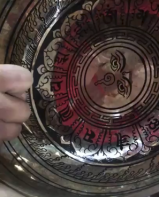
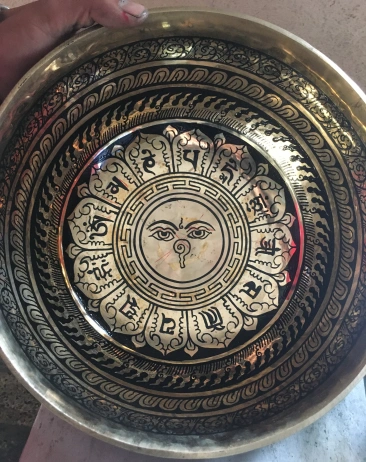
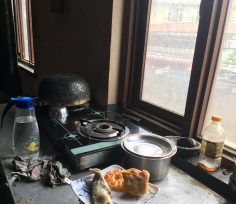
 There are tubs of nitric acid of varying sizes all around, but as this bowl will be etched only on the interior, Suraj pours the bright blue acid into the bowl up to the rim. After a 15 minute soak, he empties the solution out and scours the bowl until all of the petroleum is removed. The pattern is now visible on a shiny and golden interior surface.
There are tubs of nitric acid of varying sizes all around, but as this bowl will be etched only on the interior, Suraj pours the bright blue acid into the bowl up to the rim. After a 15 minute soak, he empties the solution out and scours the bowl until all of the petroleum is removed. The pattern is now visible on a shiny and golden interior surface.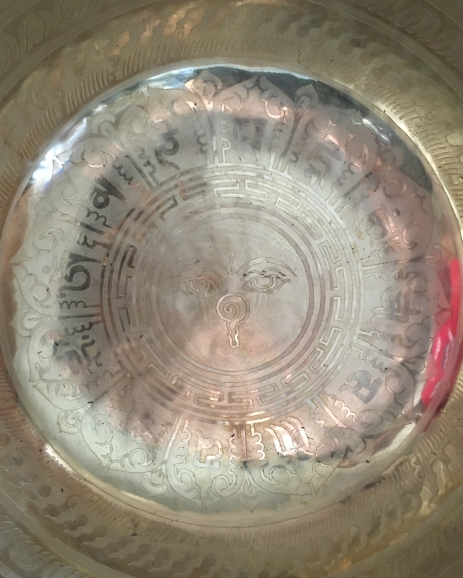
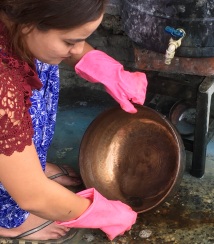 Now comes the antique color which provides contrast to the image. This is Neha’s expertise. She coats the bowl in sodium sulfide flakes, giving the golden bowl a bronze finish. She then adds a dark brown pitch, burnishing the patina and giving the pattern more definition. Their helper, Sharan Shreshta, paints a black pitch on the bowl’s exterior, and then gives the bowl a final wash. Displaying the bowl proudly, he poses with the family for a portrait.
Now comes the antique color which provides contrast to the image. This is Neha’s expertise. She coats the bowl in sodium sulfide flakes, giving the golden bowl a bronze finish. She then adds a dark brown pitch, burnishing the patina and giving the pattern more definition. Their helper, Sharan Shreshta, paints a black pitch on the bowl’s exterior, and then gives the bowl a final wash. Displaying the bowl proudly, he poses with the family for a portrait.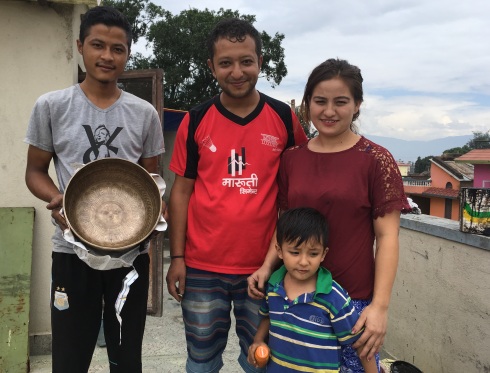 The pride the family puts into their work is so evident, and so worth it, in our opinion. The extra cost of our etched bowls are passed along to this family, and they lead a comfortable, middle-class life with a bright future. This is in keeping with Bodhisattva’s corporate mission: to keep the traditional Newari crafts alive and preserved for future generations.
The pride the family puts into their work is so evident, and so worth it, in our opinion. The extra cost of our etched bowls are passed along to this family, and they lead a comfortable, middle-class life with a bright future. This is in keeping with Bodhisattva’s corporate mission: to keep the traditional Newari crafts alive and preserved for future generations. 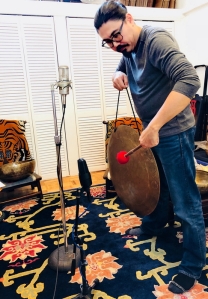 Gongs are considered by audio engineers to be one of the most difficult instruments to accurately record due to their inherent multitimbral, transient tones. You can’t approach recording them like you would cymbals of a drum set (where you place two overhead condensers in L/R position). They’re more tonally complex.
Gongs are considered by audio engineers to be one of the most difficult instruments to accurately record due to their inherent multitimbral, transient tones. You can’t approach recording them like you would cymbals of a drum set (where you place two overhead condensers in L/R position). They’re more tonally complex.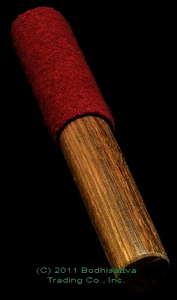
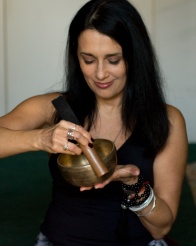 HOW TO USE IT FOR RIMMING:
HOW TO USE IT FOR RIMMING: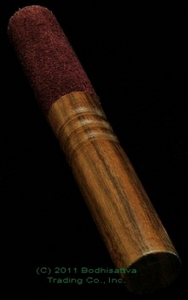
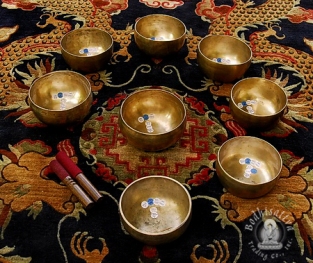
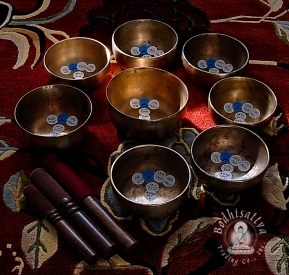
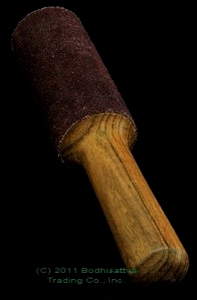
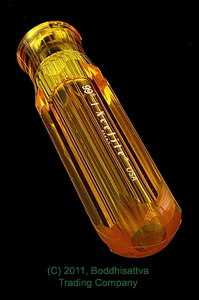
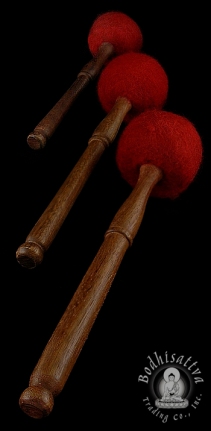
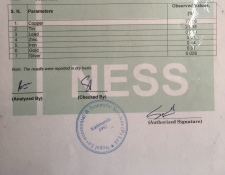 suppliers of singing bowls invited me to visit his factory in Patan, one of the three historic kingdoms of Kathmandu with an ancient tradition of metal work. He produces singing bowls of a seven metal alloy, and is the only supplier I’ve ever seen to produce a metallurgical analysis certification of the alloy content of his singing bowls. He is a major supplier to vendors in the Thamel section of Kathmandu, and also distributes to the US and Europe. As would be expected, his certification only lists trace amounts of lead, iron, zinc, silver and gold; the great majority of bell-metal bronze consists of copper and tin.
suppliers of singing bowls invited me to visit his factory in Patan, one of the three historic kingdoms of Kathmandu with an ancient tradition of metal work. He produces singing bowls of a seven metal alloy, and is the only supplier I’ve ever seen to produce a metallurgical analysis certification of the alloy content of his singing bowls. He is a major supplier to vendors in the Thamel section of Kathmandu, and also distributes to the US and Europe. As would be expected, his certification only lists trace amounts of lead, iron, zinc, silver and gold; the great majority of bell-metal bronze consists of copper and tin.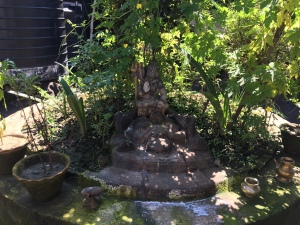 aking Bagamati river some 7 years ago after moving closer to the city from its previous location in Kakarbhitta, Eastern Nepal. It was a sunny, hot and sticky day. The racket of clanging hammers on bronze and the whining of machines greeted us as we pulled up to a massive iron gate and headed into the compound. Perched lovingly in a small garden at the center of the courtyard was a Shiva statue, freshly bathed with milk earlier in the morning. Four small satellite buildings topped with corrugated tin roofs surrounded the courtyard.
aking Bagamati river some 7 years ago after moving closer to the city from its previous location in Kakarbhitta, Eastern Nepal. It was a sunny, hot and sticky day. The racket of clanging hammers on bronze and the whining of machines greeted us as we pulled up to a massive iron gate and headed into the compound. Perched lovingly in a small garden at the center of the courtyard was a Shiva statue, freshly bathed with milk earlier in the morning. Four small satellite buildings topped with corrugated tin roofs surrounded the courtyard.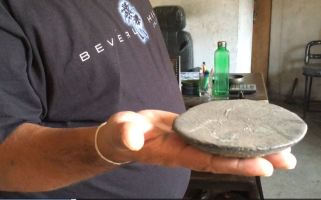 It all begins with a super concentrated disc of bell-metal. This disc was approximately 5″ across. When he handed it to me, I wasn’t prepared for how heavy it was, but of course! That metal disc would be pounded into a hand-hammered 10′-12″ singing bowl later that day. This part of the manufacturing process hasn’t changed much in 2,500 years.
It all begins with a super concentrated disc of bell-metal. This disc was approximately 5″ across. When he handed it to me, I wasn’t prepared for how heavy it was, but of course! That metal disc would be pounded into a hand-hammered 10′-12″ singing bowl later that day. This part of the manufacturing process hasn’t changed much in 2,500 years.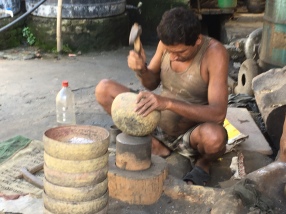
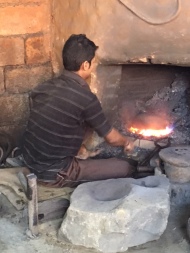 over the fire until the bowl glowed a dark red. When the red- hot bowl becomes malleable, the worker takes it out of the fire and hammers it, repeating the process until the bowl’s basic form is complete. Once cooled, the worker continues to refine the bowl’s shape, rotating it with his bare hands as he hammers. The bowls are then further hammered and refined by other workers. Then, the bowls are moved for lathing.
over the fire until the bowl glowed a dark red. When the red- hot bowl becomes malleable, the worker takes it out of the fire and hammers it, repeating the process until the bowl’s basic form is complete. Once cooled, the worker continues to refine the bowl’s shape, rotating it with his bare hands as he hammers. The bowls are then further hammered and refined by other workers. Then, the bowls are moved for lathing.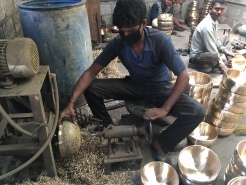 worker uses a file to trim the tops of the bowls, and a third sands their edges for smoother playing. Finally, the bowls that are destined to stay golden are taken to another shed with a huge buffing machine, where they take on a mirror like finish. Others are semi-covered in black pitch, a traditional Nepalese style.
worker uses a file to trim the tops of the bowls, and a third sands their edges for smoother playing. Finally, the bowls that are destined to stay golden are taken to another shed with a huge buffing machine, where they take on a mirror like finish. Others are semi-covered in black pitch, a traditional Nepalese style.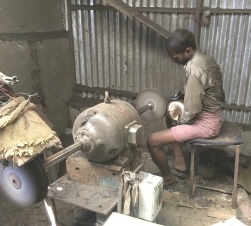 ook of our contemporary bowls for many years, until we decided to let them shine! We have now integrated these Seven Metal bowls into our
ook of our contemporary bowls for many years, until we decided to let them shine! We have now integrated these Seven Metal bowls into our 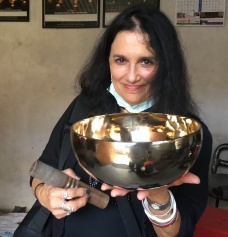 Singing Bowls
Singing Bowls

![/fhwfgLdf s]xL lbgb]lv OGwgsf] cefjn] ubf{ eb|sfnLdf t]n eg{ kfnf] kv]{/ a;]sf ;j{;fw/0f hgtf . tl:j/ k|lbk/fh jGt /f;;](https://nagashakti.files.wordpress.com/2015/10/fuel-shortage2.jpg?w=300&h=200)
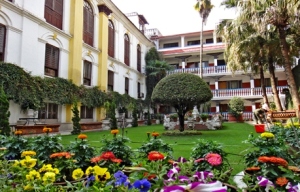
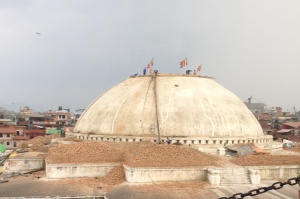
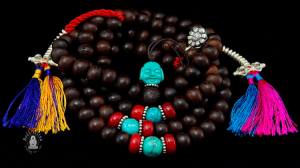
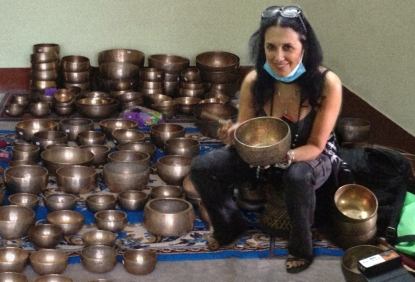
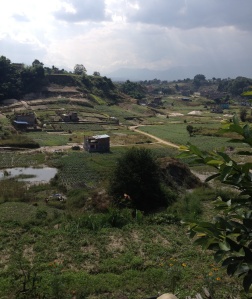
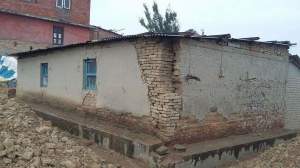
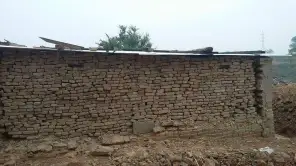
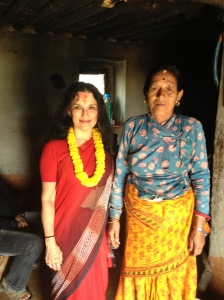
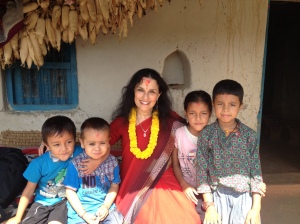
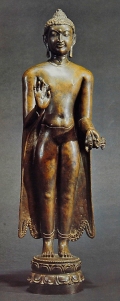
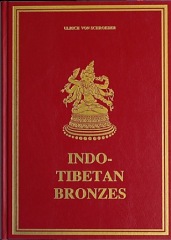 Bodhisattva’s system of dating singing bowls was developed based on the work of Indo-Tibetan bronze art historian Ulrich Von Schroeder, author of the authoritative volume “Indo-Tibetan Bronzes” published in 1981. In an attempt to discover a system of dating Info-Tibetan sculpture, Von Schroeder assembled a collection of thousands of photographs of bronze sculptures acquired from collectors and museums throughout the world. Starting with the known, dated pieces, he identified them by stylistic characteristics and classified them together with other similar pieces. This body of work then showed similar levels of wear on the surface of the bronze from handling consistent with known ritual practices, such as touching and ritual washing. Similarly, as we know how singing bowls were used and played throughout the centuries, we can observe the wear on the metal’s surface and conjecture an approximate date range of manufacture.
Bodhisattva’s system of dating singing bowls was developed based on the work of Indo-Tibetan bronze art historian Ulrich Von Schroeder, author of the authoritative volume “Indo-Tibetan Bronzes” published in 1981. In an attempt to discover a system of dating Info-Tibetan sculpture, Von Schroeder assembled a collection of thousands of photographs of bronze sculptures acquired from collectors and museums throughout the world. Starting with the known, dated pieces, he identified them by stylistic characteristics and classified them together with other similar pieces. This body of work then showed similar levels of wear on the surface of the bronze from handling consistent with known ritual practices, such as touching and ritual washing. Similarly, as we know how singing bowls were used and played throughout the centuries, we can observe the wear on the metal’s surface and conjecture an approximate date range of manufacture.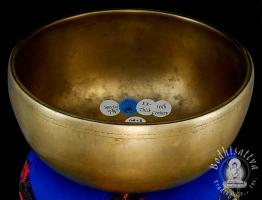
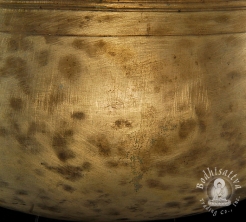
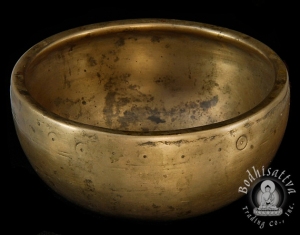
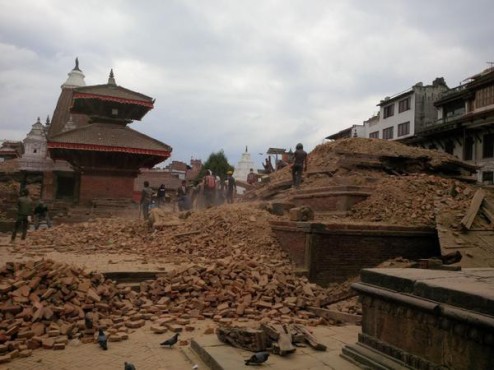
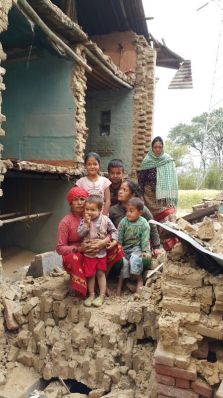
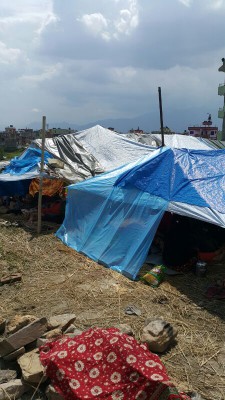

 But Seejan’s family needs help. He has drained his account and does not make enough to build temporary housing, which he estimates would cost about $2,000.00. If you wish to help Seejan and his family get back on their feet, please donate via
But Seejan’s family needs help. He has drained his account and does not make enough to build temporary housing, which he estimates would cost about $2,000.00. If you wish to help Seejan and his family get back on their feet, please donate via 